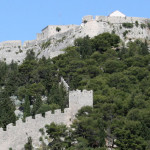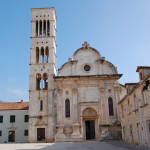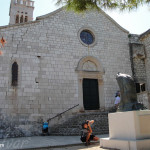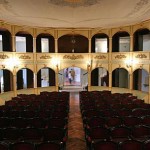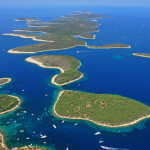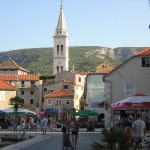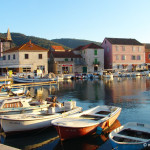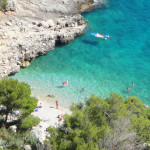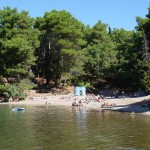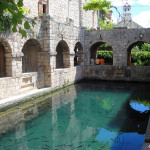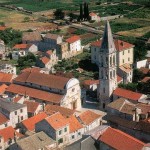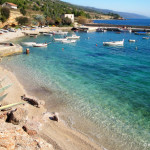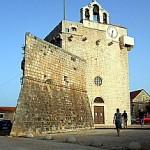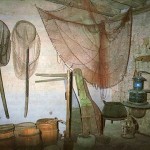The main locality are:
Hvar: the name of this town is the same of the island; is characteristic for its architecture, its central square is considered one of the most beautiful in Dalmatia, and its particular old stone cottage with red roofs. Important monuments are: Fortica Fortress, that rises over the town, was built in the 12th century but in the 16th was replaced by a new fortress erected in order to defend the population from the Turks. The St. Stephen’s Cathedral, in the center of the main square, was built between 16th and 17th centuries in place of a monastery and a former cathedral; its Renaissance bell tower preserves several rudiments of the oldest stone churches. The theater, founded in 1612, has a beautiful art gallery inside and is situated above the Arsenal that was an old warehouse of naval equipment. The Franciscan Monastery is famous for its 300 years old cypress in the cloister garden, its museum of coins, rare models of amphorae and liturgical accessories and also for the magnificent painting of the Last Supper. The harbor is well connected to Pakleni Otoci, a group of islands covered by forests, the name comes from “paklina” the resin of pine trees. You can admire rocky terraces overlooking the sea and beautiful bays. Jerolim, Stipanska, Ždrilca, Palmižana, Vlaka, are some of the small island that compose Pakleni Otoci. Night life in Hvar is exciting, restaurants, taverns and night clubs are open all night long.
- Fortezza Fortica
- Cattedrale di Santo Stefano
- Convento Francescano
- il Teatro
- Pakleni Otoci
Jelsa: is a small and quiet port town, approximately located in the center of the island. The fishing village is typical for its rich vegetation composed of pine forests and tall poplar trees. The nature lovers can walk through beautiful paths near the seashore or across alleys and squares. Bays, headlands and refreshing breezes are the ideal for the sea lovers. The famous bakery on the waterfront is a necessary stop. Restaurants and bar offer high quality foods and an excellent price/quality ratio; in every lounge bar you can also taste different kind of grappa and in nearby village of Pitva you can taste delicious seafood.
Stari Grad: is one of the oldest town in Croatia and it’s typical for its architecture and the traditional houses in local stone. The cultural monuments are numerous: the Church of St. Ivan, the Tvradalj, a fortified villa of poet Petar Hektorovic, built in 1920; the most beautiful beaches are Lanterna, a small pebble bay, about 800m. from the town center; Maslinica, about 2 km from the center, is a sand cove near a ferry pier; Banj, about 500 mt. from the center, is a bay of pebble and concrete slabs.
- Stari Grad
- Maslinica
- Lanterna
- Tvradalj
- Chiesa di S. Ivano
Zavala is famous for its pebble beaches and hidden coves, it’s the ideal for a relaxing holiday, for long walks along the seafront. From this point you can also reach the small island of Scedro, once was the port of ancient ships, today is a protected and uncontaminated Natural Park; it’s also known for its vineyards, the best wines production of Hvar.
Vbroska, is the smallest town of the island and it’s also known as Little Venice because of the small islands in the middle of the bay completely connected by bridges; and it’s particularly attractive for its location hidden in the depths of the bay. Vbroska is divided into two parts: one of these is called Podva, it’s characterized by its Renaissance-Baroque style and the series of stone houses on the coast, the other one is typical for the churches and alleyways in Gothic style. One of the main attraction is the famous Fishing Museum that preserves traditional fishing equipment and nets for fishing of all types. Santa Maria is a fortress built in the 16th century at the expense of the local people in order to defend the community against the Turks. The Church of San Lovrinac, retains an important artistic painting of inestimable value. The Church of San Pietro, one of the oldest of the island, is located at the entrance of the port. Vbroska is also known for its beaches predominantly rocky and for Zecevo a nudist island. It’s the starting point for Zlatni Rat a place on the island of Brac, characterized by luxuriant fauna and flora. Brac should be considered a natural park, especially for the part that connects Mount Vid, Zlatni Rat and the desert Blaca, creating a unique landscape.
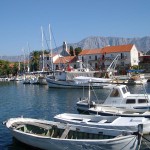 Sucuraj: is a small village on the promontory of the island, is also the closest village to the mainland and, due to its location, the coast is on both sides of the village. The history of Sucuraj was turbulent; it has been repeatedly destroyed and rebuilt as its numerous monuments including the 19th century Church of St. George from which it takes its name, the Venetian fortress of 1613, the lighthouse, surrounded on three sides by sea and rocks, the ideal place for those who want enjoy nature. Its roads are definitely typical and are linked to stone houses, this kind of constructions represented a type of defense against the attacks of pirates of Neretva.
Sucuraj: is a small village on the promontory of the island, is also the closest village to the mainland and, due to its location, the coast is on both sides of the village. The history of Sucuraj was turbulent; it has been repeatedly destroyed and rebuilt as its numerous monuments including the 19th century Church of St. George from which it takes its name, the Venetian fortress of 1613, the lighthouse, surrounded on three sides by sea and rocks, the ideal place for those who want enjoy nature. Its roads are definitely typical and are linked to stone houses, this kind of constructions represented a type of defense against the attacks of pirates of Neretva.




